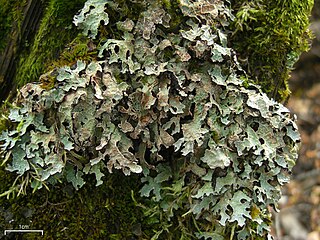
Parmelia is a genus of medium to large foliose lichens. It has a global distribution, extending from the Arctic to the Antarctic continent but concentrated in temperate regions. There are about 40 species in Parmelia. In recent decades, the once large genus Parmelia has been divided into a number of smaller genera according to thallus morphology and phylogenetic relatedness.

Peltigera is a genus of approximately 100 species of foliose lichens in the family Peltigeraceae. Commonly known as the dog or pelt lichens, species of Peltigera are often terricolous, but can also occur on moss, trees, rocks, and many other substrates in many parts of the world.

Tuckermannopsis is a genus of foliose lichens in the family Parmeliaceae.

Melanohalea is a genus of foliose lichens in the family Parmeliaceae. It contains 30 mostly Northern Hemisphere species that grow on bark or on wood. The genus is characterized by the presence of pseudocyphellae, usually on warts or on the tips of isidia, a non-pored epicortex, and a medulla containing depsidones or lacking secondary compounds. Melanohalea was circumscribed in 2004 as a segregate of the morphologically similar genus Melanelia.

Melanelixia is a genus of foliose lichens in the family Parmeliaceae. It contains 15 Northern Hemisphere species that grow on bark or on wood. The genus is characterized by a pored or fenestrate epicortex, and the production of lecanoric acid as the primary chemical constituent of the medulla. Melanelixia was circumscribed in 2004 as a segregate of the related genus Melanelia.
Psiloparmelia is a genus of lichen belonging to the family Parmeliaceae. It contains 13 Southern Hemisphere species, most of which are found growing on rocks at high elevations in South America. There are several characteristic features of the genus that are used to distinguish it from the morphologically similar genera, such as Arctoparmelia, Flavoparmelia, and Xanthoparmelia. These include a dark, velvety lower thallus surface that usually lacks rhizines, a negative test for lichenan, and a high concentration of usnic acid and atranorin in the cortex.

Imshaugia is a genus of seven species of foliose lichens in the family Parmeliaceae. They are commonly known as starburst lichens.

Xanthoparmelia mexicana, commonly known as the salted rock-shield, is a foliose lichen in the family Parmeliaceae. It grows in 4–10 cm diameter rosettes of gray-green to yellow-green lobes in arid climates all over the world.
Vilmos Kőfaragó-Gyelnik was a Hungarian botanist and lichenologist.
Hypotrachyna vainioi is a species of foliose lichen in the family Parmeliaceae. It is found in Brazil.

Peltigera lepidophora, commonly known as the scaly pelt, is a species of foliose lichen in the family Peltigeraceae. It was first described by Finnish lichenologist Edvard August Vainio in 1878 as a variety of Peltigera canina. German botanist Friedrich August Georg Bitter promoted it to species status in 1904.

Peltigera lepidophora, commonly known as the fan lichen, is a species of foliose lichen in the family Peltigeraceae. It was first described by Carl Linnaeus in his 1753 work Species Plantarum as Lichen venosus. German botanist Georg Franz Hoffmann transferred it to the genus Peltigera in 1789. P. venosa can be found in temperate and boreal regions of North America, Europe, and Asia, while occasionally being found in drier climates such as mountainous Arizona.

Peltigera degenii is a species of foliose lichen in the family Peltigeraceae. It was first formally described in 1927 by Hungarian lichenologist Vilmos Kőfaragó-Gyelnik. The Chinese species Peltigera neodegenii is similar in appearance. Peltigera degenii has a shiny upper surface. In North America, it is a relatively rare forest species.

Punctelia reddenda is a widely distributed species of foliose lichen in the family Parmeliaceae. It occurs in Africa, Europe, North America, and South America, where it grows on bark and on rock.
Usnea vainioi is a rare species of beard lichen in the family Parmeliaceae found in the southeastern United States. It was described as a new species in 1936 by Polish lichenologist Józef Motyka. The specific epithet honours Finnish lichenologist Edvard August Vainio. The lichen contains diffractaic acid as the main secondary compound.

Punctelia stictica is a species of foliose lichen in the family Parmeliaceae. It is widely distributed lichen, recorded in Africa, Europe, North America, South America, and Greenland. It is typically found growing on rocks.

Punctelia borreri is a species of foliose lichen in the family Parmeliaceae. It is a common and widely distributed species, occurring in tropical, subtropical, and temperate regions of Africa, Asia, Europe, North America, Oceania, and South America. The lichen typically grows on bark of deciduous trees, and less commonly on rock. Some European countries have reported increases in the geographic range or regional frequency of the lichen in recent decades, attributed alternatively to a reduction of atmospheric sulphur dioxide levels or an increase in temperatures resulting from climate change.

Parmelia barrenoae is a species of foliose lichen in the large family Parmeliaceae. It was formally described as a new species in 2005. Before this, it was lumped together as one of several lichens in the Parmelia sulcata group—a species complex of genetically distinct lookalikes. Parmelia barrenoae is widely distributed, occurring in Europe, western North America, Africa, and Asia.

Parmelia fraudans is a species of foliose lichen in the family Parmeliaceae. It is found in Europe and North America, where it grows on rocks.
Leucodecton canescens is a species of lichen in the family Graphidaceae. Found in Sri Lanka, it was formally described as a new species in 2014 by lichenologists Gothamie Weerakoon, Robert Lücking, and Helge Thorsten Lumbsch. The type specimen was collected from the Maussakanda Tea Estate at an altitude of 1,074 m (3,524 ft). The lichen, which has been recorded from several locations in the Central Province, grows in semi-exposed, disturbed areas at high elevations. The specific epithet canescens refers to the grey-coloured cover of the thallus.














